
|   |

|   |
1st International Convention of SPIC MACAY (20th-26th May 2013) - Dr Sunil Kothari e-mail: sunilkothari1933@gmail.com Photos: R Sreenivasan May 31, 2013 It was a sheer pleasure and a great experience, a lesson in learning attending 1st International Convention of SPIC MACAY during its 36th year celebrations at Indian Institute of Management, Kolkata. In the sylvan setting of IIM-C, its sprawling campus, with several small lakes, many residential hostels, halls, clean pathways, connecting bridges, far away from the madding crowd, at Joka, at a quiet distance from centre of Kolkata, it had a large presence of more than 1600 participants and over 200 artistes! Delegates from Pakistan, Poland, Hungary, Bangla Desh and from different parts of India had converged for a week with an unusual work schedule which prepared one for so many areas one was unaware of. On account of many other engagements and travels abroad during the month of May for the past nearly 18 years or so, I had missed these unique annual events so competently organized by SPIC MACAY and under the leadership of its Founder and Chairman, Dr. Kiran Seth. A self effacing person with an ability to inspire a generation of young students, social workers, educationists, teachers, professors, artists, connoisseurs, art patrons, agencies which support the SPIC MACAY Movement, Dr. Kiran Seth has become a legend in his own lifetime. A real karma yogi, he has inspired a core of people who work silently and with complete spirit of volunteerism, not expecting any rewards, the like of which I have not come across. Reams have been written about SPIC MACAY and its amazing reach throughout India, its remotest villages, innumerable schools, where legendary artists like Pt Ravi Shankar, Ustad Bismillah Khan, Pt Bhimsen Joshi , Prof T.N. Krishnan, Pt Birju Maharaj, Kalamandalam Raman Kutty Nair, to name a few, have offered their art to young school going generation, adults, college going students, and generated through SPIC MACAY Movement an awareness of Indian cultural heritage in its myriad forms be it classical music, Hindustani, Carnatic, folk, Dhrupad, vocal, instrumental with a mind boggling variety of Indian art forms, dance forms, their topmost exponents, who introduce the art forms to young students, explaining its intricacies to them in a most friendly manner, leading them to appreciate nuances of the classical forms of dance and music. A voluntary body, it has created wonders. When I talked to some of the participants, dancers, classical musicians, who conduct workshops known as intensives, I gained some idea of a voluntary nature of this institution. A dedicated team of workers take care of several aspects of such a mega event. Indeed someone said that such an organization is a case study for management gurus. I had attended the convention held at Dehradun in 1994 and have distinct memories of the schedule. Now it has expanded many folds and both in its scale and scope it is extremely heartening even when it appears overcrowded. What it offers you and if you participate, touches you and remains with you as a lifelong experience. You may get involved and carry on your own and you may benefit without knowing how it all began. For instance, Naad Yoga, the yoga of sound. Early around 4am, we assemble for Naad Yoga, recite the swara along with the note on tanpura, hold breath, release breath, sit for an hour and with the first ray of the sun, the yoga concludes, giving you an experience of calm and peace. Dhrupad rudra veena player Ustad Bahauddin Dagar conducts it, Dr. Kiran Seth joins, we sit cross- legged and realize what a wonderful way it makes one aware of the power of sound and yoga. The other unusual sessions were conducted by Professor P.L.Dhar, a professor of Mechanical Engineering at IIT Delhi, who has been striving to spread the knowledge of continual practice of self-awareness to sila, samadhi and pannya, as taught by Gautam Buddha. He conducted an intensive on 'Mindfulness' making students sensitive to the higher dimensions of human existence. Fascinating were yoga sessions. Swami Tyagaraj and Swami Yogapratap from the Bihar School of yoga conducted intensive yoga sessions. A large number of participating students displayed praiseworthy enthusiasm. To watch students making a beeline for it was extremely heartening. 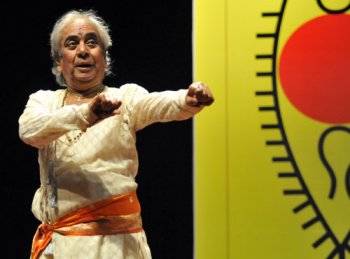 Pt Birju Maharaj On arrival on Sunday the 20th May from Delhi, with unforeseen delay of Air India flight, we missed a few important announcements, but made our way to the main auditorium to witness performances by Pt Birju Maharaj. He has great charisma and has won over his audiences, be they students or ardent fans with his unique ways of performing delicate, small pieces, laced with humorous comments and investing them with superb laya and movements. Birju Maharaj's Kathak has reached its zenith and to describe the maestro's charms will be like 'gilding the lily.' His prime disciple Saswati Sen explained the intricacies of Kathak and performed with Úlan. She was joined by Luna Poddar and along with Birju Maharaj the two performed, giving glimpses of Kathak to a full house, students and adults sitting on the floor, maintaining pin drop silence. This was wonderful and throughout the week all sessions were after initial noise turned into such peaceful sessions that one enjoyed whatever was presented with great delight. We writers were all accommodated at Tata Hall hostels along with musicians, dancers, few key organizers and painter Anjolie Ela Menon. Therefore when we went to the dining hall for morning breakfast, we were able to meet each other, sit together, exchange views, latest news in the art world and enjoy these meetings. Young Koodiyattam exponent Kapila Venu, Dhrupad musician Ustad Bahauddin Dagar, Pelavi Naik, Astad Deboo, Chitra Visweswaran, musician R. Vedavalli, Parvathy Baul, yoga teachers, dance and music intensive artistes Uma Rama Rao for Kuchipudi, Sharmila Biswas for Odissi, Malabika Mitra for Kathak, Rani Karnaa for Kathak to name a few would join us and it was such a rich experience to listen to them and exchange views. I shall always remember these morning sessions. From next morning, the 21st May from 9.30am at another block Lake View Hostels, the dance and music intensive sessions were held. We would head for that and watch workshops, senior dancers teaching young participants the simple steps, leading to complex movement, telling anecdotes, making them laugh, feel relaxed and encourage them to develop confidence and command over the technique, even if they did not study dance earlier or even that particular dance form. We headed for Guru Ghanakanta Bora's Sattriya, classical dance form of Assam. My book on the subject was released on 19th May at India International Centre in New Delhi. I was anxious to meet Guru Ghanakanta Bora, his disciples Anwesa Mahanta and Dwijen Barman, who assisted him to watch how they were transmitting the technique. The basic stance, few of the Mati Akharas, ground exercises and Vandana, the prayer shlokas were planned out to teach within short period. The shloka was explained, written by each student with meaning and hand gesture, and the physical exercises were taught. It is always fascinating to see how the technique is transmitted by the senior guru with the help of assistants, to young bodies. Their curiosity for this new form and wish to learn it were sincere. None was inspiring to be a perfect exponent. But along with physical training, they were taught a lot about the culture of Assam, Saint Sankaradeva's philosophy, costumes, songs, the total environment which prevails in Sattra, the monasteries and the lifestyle of monks. Guru Ghanakanta Bora was a monk at Kamalabari Sattra where he was trained in playing mridang, khol, and perform dance, sing songs and so on. Therefore in this workshop, one was to watch direct training being imparted by a traditional guru of a form which has received recognition as a classical dance form in recent years only. It would be invidious to single out any one or two intensives, workshops. But one by senior exponent Chitra Visweswaran in Bharatanatyam was very interesting. With her two senior students, she was giving those who had registered for Bharatanatyam, instructions which were joyous. The teaching was made interesting by cajoling them, making them conscious that they are to dance with joy. On the last day on 25th May, these students were to give within five minutes some glimpses of what they had studied. And Chitra's students performed so well that one indeed was surprised to see such good result. Sharmila Biswas, a disciple of Guru Kelucharan Mohapatra, is known for her innovations and group work. When we watched her class, some students were being trained outside and others were forming groups inside the class room. Sharmila was choreographing group work making all participants dance. The circles were formed, the lines were designed, the Goddess with multiple arms with various war implements was 'figured,' the demon was to be annihilated, lying prostrate before the Goddess. All came through well and during the last day presentation it won rounds of applause. One morning, we moved to Parvathy Baul's workshop. The ten male and female participants were made to repeat after her the song in Bengali, describing that one has to know one's own inner self, even when the physical food is not available; one has to strive for knowing inner being. She sang and made participants sing with her. She asked two to three students to take rounds, teaching them breathing control and moving in a circle. It was quite fascinating to see participants getting into the spirit of the song, the movements and the Baul devotion! 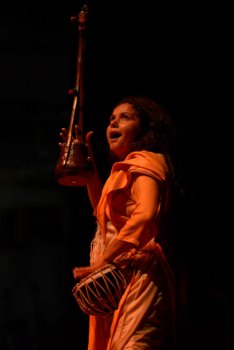 Parvathy Baul 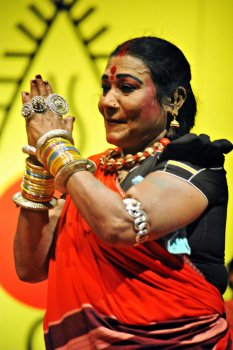 Teejan Bai The most fascinating workshop must have been of the Pandavani singer Teejan Bai. Though we had missed it, we witnessed the training in a brief presentation. Her stories from Mahabharata episodes are fascinating with back up boys playing musical instruments and speaking in support with her narration. In the brief presentation, a young girl imitating style of Teejan Bai spoke of Arjuna practicing penance and seeking 'pasupatastra' from Lord Shiva. To test his prowess and devotion Lord Shiva turns into a hunter and Parvati as huntress and disturb him, shooting a pig. Arjuna gets angry and challenges Lord Shiva in disguise and both fight. In the end Arjuna recovers from his unconscious state, the Lord reveals his original form and gives him Pasupatastra. The young girl carried her acting imitating playing instrument and delivering dialogue as taught by Teejan Bai. Having seen Teejan Bai perform the previous day, one indeed thought it was a miracle that within five days with three hours per day intensive training they could learn so well. That Teejan Bai could achieve this appeared to her also 'a mini miracle'! Kathak by students trained by Saswati, Dr. Malabika Mitra and Rani Karnaa, displayed their individual styles. Students of Birju Maharaj, Saswati Sen displayed flair for chakkars, pirouettes; Rani Karnaa's students showed controlled Surya Stuti; Malabika's students performed small pieces tode, tukde and danced well what they were taught. Uma Rama Rao's two senior disciples taught under Uma Rama Rao's guidance, Kuchipudi numbers, which had its verve and traditional flair. With constraints of time, the results of workshops were severely curtailed, but one could gauge from what one saw that within five days, the participants had made sincere effort to imbibe the movements and spirit of the form, be it classical dance or music. In Kapila Venu's Koodiyattam workshop, her distinct, crystal clear enunciation of shlokas rang out in the early morning. The participants moved the way she showed them to move. Koodiyattam is a difficult dance-theatre form and needs understanding of breath control. The very fact that the young participants moved on the stage to the beats on Mizhavu drum was quite interesting. There were workshops opposite main auditorium under a big pandal across the ground, where several craftsmen were training young participants on various crafts, block printing, paper mache, wood carving, clay images, Madhubani painting, Patua painting, Srinathdwara painting, Pattachitra painting from Odisha, weaving. In his intensive, the puppeteer Sudeep Gupta threw light on intricacies of the art form of puppetry- the range was fascinating and one watching intensives, learnt a lot, even when one had a nodding acquaintance with the crafts. The Mughal wood carving was extremely intricate. One of the participants from Pakistan mentioned during the presentation that he found these cultural links deep and was moved studying with the crafts guru. There were tribal paintings from Saora tribe from Odisha, Mooj grass craft, terracotta and Bandhej, the tie and dye from Rajasthan, Gujarat. Some we saw during the presentation and felt grateful to Neeraj Sareen for taking such deep interest in our crafts, which is part of our heritage, and organizing on such a large scale. That SPIC MACAY over the years has made these intensives inclusive has to be complimented because besides dance and classical music to generate awareness about these crafts is so precious. What was very helpful was the souvenir SPIC MACAY has brought out, which covers not only the bio-datas of the participating dancers and musicians, but also brief introductions to the crafts persons who have won awards at both national and international levels and they took time off to come over and stay with all and conduct the workshops. The souvenir carries interesting articles by Jaywant Naidu of Hyderabad Chapter, a Chartered Accountant and a classical Hindustani musician playing upon guitar which he has termed Jayawant Guitar. Manjari Sinha's 'down memory lane' in her inimitable Hindi, is replete with fond memories of legendary masters like Bhimsen Joshi, Ustad Rahim Fahimuddin Dagar, Ustad Bismillah Khan and Kalamkari artist Guruppa Shetty's interaction with him during Suratkal convention. Besides, there are Ustad Asad Lai Khan's anecdotes. Ustad Bahauddin Dagar's article on Dhrupad, a language of resonance, Shashi Banerjee's Making a difference on volunteerism, Dr Kiran Seth's 'Check it out' drawing attention of the youth to core values, informing that what has taken a beating are faith and patience in current atmosphere of instant gratification resulting in people not being able to recognize a great master even if they come across one, is so correct and timely. He has rightly observed that the youth will have to develop the inner strength to go through life relatively unscathed. His emphasis on our heritage can construct this support system beautifully. Other articles by Leela Venkataraman, Madhavi Puranam, and one by Varadarajan on Vivekananda, provide food for thought. SPIC MACAY 'Vision 2020' article aims to cover every child in the govt. schools and expose them to the richness of various aspects of our rich and composite heritage like classical music and dance, folk dance, theatre, yoga, meditation, inspiring talks by eminent people, heritage walks, holistic food, cinema classics etc. It mentions: Over past 35 years of its existence, SPIC MACAY has spread to about 350 cities and towns all across the country. By 2020, they wish to reach out to the rural parts covering almost 17 lakhs schools and colleges. Good support has come from Sarva Shiksha Abhiyan and Rashtriya Madhyamik Shiksha Abhiyan in several states to reach out to the rural students of the country. Their efforts are to take the arts and the crafts to the young minds, to let them experience it first hand and get a glimpse of things which are from their own native land. It would be an occasion for the children to experience these art forms which they would have otherwise not seen or heard about due to variety of reasons. The more I read about all these projects, the more I could learn about SPIC MACAY's work besides promoting and preserving classical dance and music amongst our youth. A voluntary non-profit movement founded in 1977 by Dr. Kiran Seth along with dedicated academicians and students, presently has more than 300 chapters in India and abroad with thousands of volunteers working selflessly. It helps organize lectures, demonstrations, intensives (workshops), informal discussions, and seminars on a variety of art forms in various educational institutes, schools, and colleges. More importantly, it creates a space for students to informally interact with great masters of art and also be the participants in knowledge and preserving their heritage. Another souvenir of SPIC MACAY which I received is on Workshop Demonstration Programmes Govt schools-Rajasthan: A New Beginning. Under Vision 2020, Rajasthan Board of Secondary Education (RBSE) has issued a circular to all the RBSE affiliated Govt. schools, asking them to conduct SPIC MACAY activities. There are around 11,000 such schools in Rajasthan. Students studying in these schools are from very poor families. SPIC MACAY moved first step ahead on this long road and conducted 647 programmes in various schools of Kota, Bundi, Barmer, Jaisalmer, Jodhpur and Chittorgarh from March to September. Various artistes of vocal music, Odissi, Kathak, Bharatanatyam and Rajasthani folk performed for them. The workshop demonstration module subjects students to 45 minutes of workshop followed by 45 minutes of performance by the artist.The students sing bandish, sargam of the raga, to perform basic steps of Odissi or any other dance form, with a small performance of some 'stuti' prayer and when students watch the artistes perform, it makes deep impression on them. The souvenir relating to Rajasthan gives date wise from February till 29th September, details of workshops conducted. The statistics indeed are impressive and till one browsed through in detail, one would not have even understood the wide reach of SPIC MACAY in this direction. Dr. Kiran Seth is a firm believer in 'Rediscovering the spirit of Volunteerism.' He says: "True volunteerism has almost disappeared from society. We have many people 'volunteering' but usually this comes with many perks which are very attractive. Even if this is not the case, a contribution is made wherever it is comfortable and also results in 'a feel good factor.' For voluntary effort to be really meaningful, it must involve some pain and also no direct gain to the volunteer. This is 'a very difficult call' to make in this day and age where transaction is supreme and the ability to recognize the intangible is very little." Dr. Seth aspires to inculcate this spirit through the educational system. School and college students are encouraged to volunteer, but the effort requires to be stepped up and the need for it ought to be explained more clearly to them. "True volunteerism leads to a more giving society which in turn brings with it peace and harmony. If many people are encouraged to volunteer at least some are bound to recognize what true volunteerism is all about. They will in turn be able to communicate it to the next generation and so the tribe will increase." Interaction with painters The experiences at the convention were varied and enriching. In Delhi, during exhibitions we bump into artists, but never do we sit at leisure and interact or talk with them, as the pace of life in the Capital is very fast. Therefore, a session with Shanti Niketan based painter Jogen Chowdhury was quite stimulating. In a student friendly manner he explained the basic elements which go into making a painting, a drawing. He drew attention to elements like space, negative space, imagination, colours, and other technical matters. He drew figures on a board, but it would have been far more interesting if he had made a power point presentation of some of his paintings. He was quite disarming and charming in answering the questions. He donated one of his paintings of Gurudev Tagore to SPIC MACAY. Anjolie Ela Menon is a name to reckon with in the world of paintings. A prolific painter, her paintings are well known to a large community of art lovers. Also her murals have drawn attention. She showed a number of slides of her colourful paintings, tracing how she began painting and how she used windows, spaces seen beyond, the birds, the atmosphere, sky and showed a series of paintings which enchanted the large audience. She spoke intimately and with warmth and also answered questions about paintings including nudes of women. She showed the latest mural for Delhi airport which shows life in a street and mirrors life as observed. It is to be inaugurated in June. There is a certain warmth in her paintings, the colours speak to you and the themes touch you. She is a figurative painter, but also admires abstract paintings. During her stay at IIM, she drew a painting and donated it to SPIC MACAY. Closely associated with SPIC MACAY, she is on its national committee. She spoke about her involvement in the SPIC MACAY movement and over breakfasts and dinners, interacted with musicians, dancers and critics. It was a sheer pleasure to meet her at leisure. Having known both Jogen-da and Anjolie, the convention offered us an opportunity to know them from close quarters. The support from such renowned painters inspires the young generation. The intensive with her resulted into a painting by some six participants and a lovely plate of colours which Anjolie turned into a work of art. Film screening: 'Bhuvan Shome' directed by Mrinal Sen The convention also has a screening of a classic film. Having seen 'Bhuvan Shome' many summers ago in Mumbai, I had completely forgotten the humour within the film, acted so marvelously by the thespian Utpal Dutt as Mr. Shome. As a senior Railway officer, very strict, he decides to take one day off and go for hunting in a village in Gujarat. A ticket collector, who as 'regular routine' takes 'chai pani' bribe from passengers, has been reported to Mr. Shome. He happens to meet a young maid betrothed to the ticket collector, but she does not know the senior officer is Mr. Shome. During interesting encounters of hunting a bird, he realizes the innocence of the young girl played so sensitively by Suhasini Muley. He is moved deeply and pardons the ticket collector. But there is a twist - the ticket collector writes to the bride that he has been pardoned and promoted. And the promotion would mean bigger 'chai pani.' The entire film with its exquisite filming and memorable shots leaves an indelible impression. This initiative of SPIC MACAY would leave a far deeper impact in view of the present Bollywood masalas being offered to the young generation. Even one viewing of such films I believe would act as a corrective. I was fortunate to have met and known Mrinal Sen when he was directing 'Matir Manish' film in Odiya, for Babulal Doshi in Cuttack. Later on one knew Mrinal-da more over many years and during my stay as a Professor and Head of Dance Department at Rabindra Bharati University at Jorasanko in Kolkata. Now advanced in age, Mrinal-da does not move out much. But his films need to be seen by the young generation. Raas Sankirtan from Manipur In dance besides Birju Maharaj, the other greats were from Imphal, Manipur Guru Thanil Singh and (PAL) Progressive Arts Laboratory's troupe of Natasankirtan and Rasalila. One of the memorable presentations, quite elaborate, was theirs. A variety of movements, Karatal Cholom, cymbal playing, pung, drum playing and singing describing Krishna going to graze cows, Gaurlila, and intricate movements while playing drums and simultaneously dancing left one wondering at the depth of this rare dance and music form. Typical and specifically regional, Natasankirtan forms the backbone of Rasalila. Rasalila is always performed after the Natasankirtan. Seeped in devotion, the all male ensemble dressed in spotless white dhotis and pugrees, holding cymbals and two drum players holding drums, creates very impressive visuals. After Natasanskritan follows Rasalila. The dancers presented Basant Rasa, incorporating Holi and excerpts from the immortal Gita Govinda ashtapadis, evoking devotional mood. The young female dancer, who played role of Krishna for the first time, was indeed a very gifted artiste. Others were well trained. The aharya of Manipuri Rasalilas are colourful and the mirrored skirts, gossamer veils, ornament, crown et al creates a magical vision and cast a spell on audiences. Praneswari's soulful singing added another dimension to the presentation. Such sights indeed are sights for the gods. In the finale when conch is played and arati is offered to the yugal swarup of Krishna and Radha, one is transported to Brindaban, so powerful is the impact of the presentation. The group leader Tiken Singh is a versatile artiste. PAL began under celebrated theatre director Ratan Thiyam's father Tarun Kumar Thiyam's guidance. They are doing commendable work training young dancers in traditional dance forms. Bouquets to SPIC MACAY for providing the young generation with such exquisite Manipuri tradition! In Koodiyattam, Kapila Venu has rightly earned the reputation as a gifted exponent. Trained from childhood under the legendary Ammannur Madhava Chakyar and her own father G Venu, she is continuing further study from other great guru Kitangur C.N. Rama Chakyar. She presented Sita Parityagam episode, which was heart rending towards the end, when Sita learns Rama has once again banished her to forest on hearing unpleasant rumours, and that too she had already been subjected to Agni Pariksha. Her delineation of various moods, characters, training Lava and Kusha and refusal to be with Lord Rama, returning to mother earth was so intense that it hit the hearts of rasikas. The agony of Sita portrayed by Kapila would remain etched in memory for long. A brilliant artiste, she kept the audience captive with her performance. The audience watched her in complete silence and with full attention, so powerful was the performance. Astad Deboo with his wonderful warm hearted greetings and sense of humour performed to Ustad Bahauddin Khan's rudra veena music and astounded one and all with his more than 300 pirouettes to the music of a Japanese musician. His intensive had enthusiastic participants who danced in order and with simple movements giving a glimpse into Astad's training approach. Kalamandalam Gopi, the Kathakali exponent, given more time would have astounded us with his abhinaya, which is a privilege one gets to watch during such conventions. One recalls Pavathy Baul's trance like performances with her excellent renderings of songs. Teejan Bai's art of storytelling is known and if she had not been unwell, she would have surely performed elaborately. Since I was attending the convention after a long interval, I was delighted to take in as much as I could. And now, as what Manjari Sinha says, "These conventions are our annual pilgrimages!" Regarding vocalists, if you have legendary nonagenarian Ustad Ali Ahmad Hussain Khan saheb, what more could you ask for? His booming voice startles the young musicians who are in awe. He regaled the audience with rare compositions, even a ghazal in Arabic. He is a treasure trove of Hindustani music paprampara. 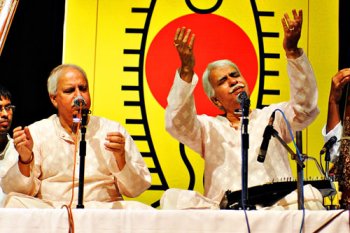 Rajan - Sajan Mishra 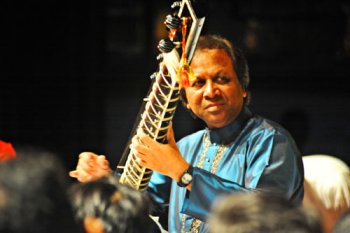 Shahid Parvez 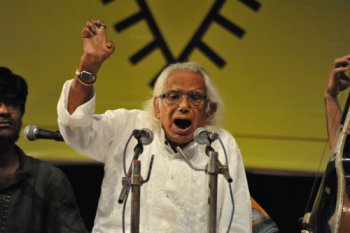 Ustad Abdul Rashid Khan 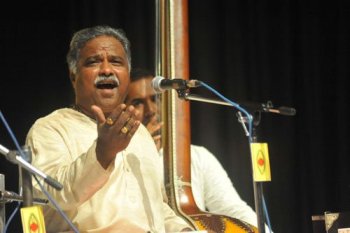 Venkatesh Kumar I was singularly fortunate to be with Manjari Sinha, who during the recitals of Rajan - Sajan Mishra, Buddhadev Dasgupta (sarod), Ulhas Kasalkar, Shahid Parvez (sitar), Ajoy Chakrabarty and others, with gentle comments offered insights into their recitals, handling of the ragas, the rasasthanas, the points of rasa. When T.N Krishnan played violin, he explained to audiences, mainly for the benefit of young students, what is Ragam, Tanam and Pallavi. Then with his inimitable playing of violin, he transported us to rare samadhi. I missed M. Venkatesh Kumar and T.V. Sankaranarayanan's performances during the whole night event. But whatever I gained listening to Pt Shivakumar Sharma, Agra gharana vocalist Wasid Ahmad and others, I shall treasure for long. We all were making copious notes, writing down the bandishes, comparing them and relishing the music. It was like old times in Mumbai attending Sur Singar Samsad's Swami Haridas Sammelans and also whole night performances. It evoked strong memories and I felt beholden to SPIC MACAY for this golden opportunity to revisit musicians, their compositions, and enjoy the music. With my preoccupation with dance more than with music recitals, these recitals and performances gave me wonderful insights into the art of these stalwarts. That SPIC MACAY offers all this to the young generation on a silver platter has been recognized by the government agencies and also those who love music and dance. None bothered about the humidity, heat, and practiced with joy, ignoring physical discomforts. Where on earth could one get such opportunities to gain through generous giving by the great masters? The convention is held in the month of May when schools and colleges are closed for vacation. And this is the best time to organize the conventions, as the various institutions can provide them infrastructure as they too have vacation. That more than 1600 participants can assemble at one place and attend such amazing fare by more than 200 artistes is mind boggling. In sheer terms of organizing, planning, entrusting responsibilities to those involved, looking after the artistes, their arrivals and departures, etc., were being looked into with meticulous care and none minded any inconvenience. The spirit of volunteerism, service and to reach out to the young generation was felt and one could see why SPIC MACAY as a movement has spearheaded so well over past 36 years! One feels sanguine that the movement would continue on its own strength.  Dr. Sunil Kothari is a dance historian, scholar, author and a renowned dance critic. He is Vice President of World Dance Alliance Asia Pacific India chapter, based in New Delhi. He is honored by the President of India with Padma Shri, Sangeet Natak Akademi award and Senior Critic Award from Dance Critics Association, NYC. He is a regular contributor to www.narthaki.com, the roving critic for monthly magazine Sruti and is a contributing editor of Nartanam for the past 12 years. Responses * Thanks for the detailed report. We missed it. - Hemant Nanavaty SM, Junagadh (June 1, 2013) hemantdnanavaty@gmail.com * This is a report which will help those who could not attend the convention. A kind of complete history of the convention. I salute Dr. Sunil Kothari. Sanjib Ganguly sanjibganguly@gmail.com (June 13, 2013) Post your comments Pl provide your name and email id along with your comment. All appropriate comments posted with name and email id in the blog will also be featured in the site. |